
Basic Information
| Country Name | Islamic Republic of Pakistan |
| Capital | Islamabad |
| Population | 195.4 million people (Pakistan Economic Survey 2015-16) |
| Area | 796,000km2 |
| Demographics | Punjabis, Sindhi, Pashtuns, Baloch |
| Languages | Urdu (National Language), English (Official Language) |
| Religions | Islam |
Project to support the improvement of the educational environment for children in Kulam district, Khyber Pakhtunkhwa (KP)
Background
The school enrollment rate in the former FATA [1] [2]is 40.38%. Out of the enrolled students, 73% of girls drop out. This high percentage is caused by the insecurity of girls and parents about spending time in schools with low or no external walls (due to the culture's emphasis on 'parda [3]'), as well as the lack of toilets in schools. After identifying the cause of the low enrollment rate, we have implemented sustainable solutions to support the improvement of children's educational environment. Listed below are the causes of low female enrollment in schools:
(i) Undeveloped school facilities:
Kurram province is said to be the most marginalized province in Pakistan, with the most destroyed schools and sanitation facilities due to terrorism, conflict and sectarian strife, resulting in the greatest need for reconstruction and repair. Of the total 708 schools (including girls', boys' and co-educational schools) in the Kurram province, 55% have no sanitation facilities and 96% have no classrooms. Of the 4% of schools with classrooms, 30% have no external walls. Of the 45% of schools with sanitation facilities, the infrastructure is of poor quality, lacking proper sewage and drinking water, creating water sanitation problems.
(ii) Unhygienic conditions:
Disease spreads rapidly when schools do not have hand-washing facilities, soap, or when toilets are in poor condition. In schools in the Kulamu District, hygiene education is not provided, and students lack hygiene awareness, having little to no habit of washing their hands with soap. Nearly 60% of children suffer from acute waterborne diarrhea.
(iii) Mental health problem:
Even for students who are able to attend school, nearly 20% have problems attending school due to mental health problems. This is caused by conflict and terrorism [4], which prevent them from fully understanding and maintaining interest in school lessons.
Project description
This project aims to improve sanitation and increase student enrollment (especially for girls) by bettering the infrastructure of eight schools in the Kulam district. The project plans to sustain the improved sanitation conditions and facilities by training students in hygiene education, psychological care, and function of sanitation facilities.
(1) Improvement of the learning environment (school and sanitation facilities) [5].
The project will repair existing facilities and construct new ones. The project will provide school equipment such as chairs and desks for students and teachers, shelves to store learning materials, and more.
The project will also provide facility maintenance training for Parent Teacher Committees [6] (PTCs) and teachers.
(2) Hygiene education, psychological care, and teaching the use of facilities:
The project will provide hygiene kits for schools and students, hygiene education and mental health support training for PTCs and teachers.
The project will then conduct hygiene education, mental health, and facility use awareness training for students.
Beneficiary population of the eight targeted schools: 3,187 people
Breakdown:
80 male students
3,022 female students
29 teachers
56 PTC members

The building of a brick wall to provide privacy.
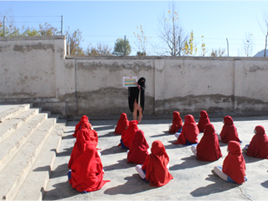
Hygiene education for students being conducted outside.
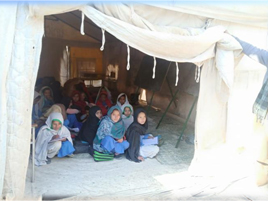
Students taking classes in a tent prior to the start of the project.
How to ensure a sustainable situation
Once the school facilities are constructed, they will be officially handed over to the Kulam District Education Department. Under the supervision of the Education Department, the Parent Teacher Committee (PTC), which JEN has worked with in the past, will be responsible for the maintenance of the school’s facilities. The PTC will also play a role in continuing to provide hygiene education and psychological care to students, as well as awareness training on the proper use of the facilities.
Livelihood-Infrastructure Support Project Focused on Pest Control, Inspection, and Management for Farmers in the Three Districts of KP Province Most Affected by Pest Damage (July 2020〜)
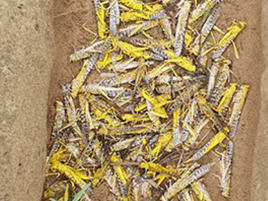
Locusts from our preliminary inspection of the area
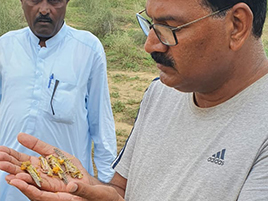
Locusts from our preliminary inspection of the area
Background
In early 2020, various regions in Pakistan experienced serious pest damage. Especially in the D.I. Khan District of KP Province and in the Tharparkar District of Sindh Province (as of September 2020, swarms of locusts infested the area and left significant damage), the extermination of pests was an urgent task. Furthermore, looking at the climate of the region, recurrent infestations are likely to occur. It was revealed that serious damage occurred even on pastures not included in the government’s extermination plan. For the most part, the livestock farmers that utilize these pastures practice grazing, and they rely on the grass found on the pasture as the main source of food for livestock. Therefore, due to the loss of the grass, the livestock experienced significant weight loss and became more susceptible to various diseases, which ultimately put the farmers in a vulnerable position.
Abstract
We worked to control crop damage for farms in the D.I. Khan District of KP Province and in the Tharparkar District of Sindh Province by providing the necessary materials and equipment and introducing an early-warning mechanism1 against pests. Concurrently, through providing emergency aid for livestock farmers who suffered from pest damage, we worked to deliver foundational support to rebuild their lives that were lost due to the damage. Due to the migratory behavior of the locusts, we shifted our target area from the three districts in KP Province (Lakki Marwat, Tank, D.I. Khan) to the two regions mentioned above.
Project Description
Distribution of required materials and equipment for pest control, and the implementation of joint pest control efforts
●Upon identifying beneficiaries, we organize groups for locust control and select target farmlands.
●We provide pest control training to locust control group (LCG) members and government officials, distribute agricultural sprayers and protective gear (masks, gloves, glasses, and hats), and practice monitoring on-site pest monitoring trainings.
●We implement joint pest control efforts between the groups and local governmental officials on varying topographical regions.
Creation of early-warning mechanisms for pests, and reinforcement of the structure of monitoring and managing pest control efforts
●We provide training on early-warning mechanisms, and conduct practice for monitoring pest levels on the farmlands.
●In order to ensure sustainability of the practice after the completion of the project, we (our district coordination officers) gather information and work on succession in Locust Control Room of the local agricultural bureau.
●Upon sharing IEC (Information, Education, Communication) documents that covered all components of the project with authorized personnel and members of the LCG, we carry out awareness programs throughout the project.
Emergency assistance for livestock farmers that suffered from pest damage
●We establish our targets to be the two union councils (UC: towns) located in D.I. Khan District and four UCs located in Tharparkar District that experienced the most pest damage. Further, we target livestock farmers who, due to the pest damage, have experienced poverty and are in need of urgent assistance.
●Simultaneously, we recruit three livestock assistants through cooperative efforts with the local livestock bureau. These three assistants (one in D.I. Khan District and two in Tharparkar District) perform vaccinations for small-sized (20,500) and large-sized (4,100) livestock owned by 4,100 households in the target area.
Additionally, the assistants provide antiparasitic treatments for livestock that had experienced a deterioration of health due to the pest damage.
●We distribute livestock feed to each household in the target area. We also host awareness sessions on health management of livestock for farmers that experienced significant levels of pest damage.
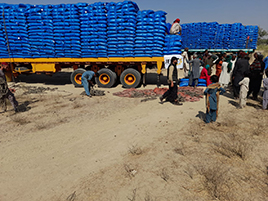
Livestock feed for distribution piled on truck
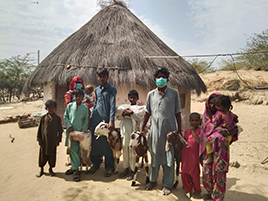
Photo of a farmer household that had suffered from pest damage, taken during distribution efforts of livestock feed
Project on Improving the Learning and Studying Conditions of Sarpakh All-Girls Junior High School located in Kurram District, KP Province (October 2020〜February 2021)
Background
Currently, we are carrying out projects concerned with improving the water and sanitation conditions in the Kurram District. In order to further examine ways in which we can support this District and its reconstruction efforts, we conducted various surveys and investigations with the cooperation of local community members.
The overall literacy rate in the Kurram District is at a crucially low value of 33%, and the literacy rate for women is at an even lower value of 13% 1
The low literacy rates in the Kurram District, compared to other regions in Pakistan, can be linked to destroyed buildings due to civil wars and acts of terrorism, which has made it difficult to establish conditions in which girls can study in a safe and effective manner. There are also many girls who are unable to attend school due to religious reasons. Various research have revealed a positive correlation between the female literacy rates and the quality of lives of the people in the region.2
Project Description
The Sarpakh All-Girls Junior High School is the only all-girls junior high school found in the 15 villages surrounding the Kurram District. Junior high schools in Pakistan are typically attended by children between the ages of 10 and 12.
This All-Girls Junior High School lacks various facilities that would make it safe for girls to attend school. Through multiple meetings and discussions with the faculty members of the school, we identified 4 components that need to be addressed immediately. Addressing these four components will cost a lot of money, but this support is important because students' parents are in poor economic situations and government assistance is difficult to reach. In this project, we aimed to mainly establish and reinforce various facilities of the school, and through this, we hoped to see an improvement of learning conditions, and ultimately an increase in the literacy rates of girls.
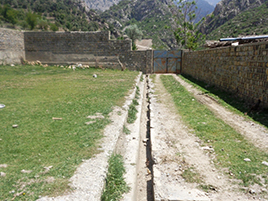
Schoolyard cracked by a damaged drainage pipe
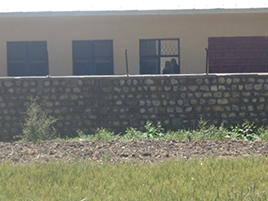
A classroom can be seen from outside
Project Report
Through improvement of existing resources (expansion of the exterior wall surrounding the school, reparation of the drainage system), and supply of playground equipment and books, we were able to successfully implement a safer environment in which the 149 students of this school could study in. This project could not have been possible without the generous donations from our supporters through crowdfunding. We would like to express our sincere gratitude for the continued support.
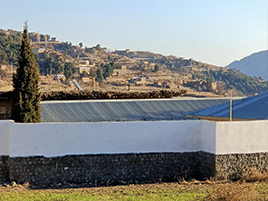
Renovated exterior wall
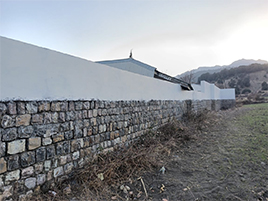
The classrooms can no longer be seen from outside
We began preparation efforts and collected materials needed for the project in October of 2020, and construction began in November.
The construction process was as follows:
1.Preparation of estimates through examining the current state of the exterior wall
2.Looked for and reached an agreement with service providers
3.Reparation of the exterior wall
4.Reparation of the drainage system
5.Installment of playground equipment (swings, etc.)
6.Construction of a library with books
7.Transfer of management to school officials
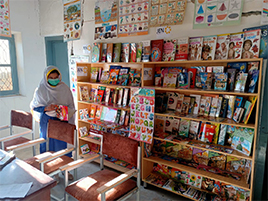
Books have been arranged in the library
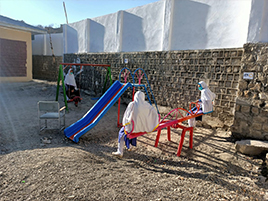
Playground equipment installed in the schoolyard
We worked to finish the construction of the exterior wall before the harsh winter hit.
Additionally, we saw students, teachers, and members of the local community attend and participate in the handover ceremony hosted on February 1st.
During the monitoring phase, many students talked about how their classmates and friends may now be able to come back to school, thanks to the construction of the exterior wall. Other students expressed their excitement about being able to go outside and play on the playground equipment during break periods, since they were not able to do that before.
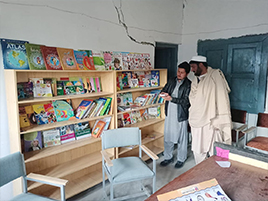
Scenes from the handover
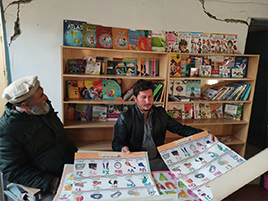
Elders(community leaders) looking at the
completed library
The project to improve the base of livelihood including rehabilitation of water and sanitation facilities for returnees in Upper area and Central Kurram area in Khyber Pakhtunkhwa (KP), Pakistan (Sep. 2019 – Jan. 2021)
As of September 2019, Kurram district had no adequate schools and medical facilities with drinkable water, sanitation facilities or dust bins. The students did not have enough knowledge about hygiene such as washing hands and they did not have choice to defecate outdoor, because there were no toilets at the schools. The fact that the schools did not have toilets affected the percentage of school attendance of the girls especially.
As water supply support activities, JEN secured the water source and ensured access to safe drinking water by establishing new drinking water supply schemes(water supply pipe-lines, water collection tanks, surface water tanks and etc.) and water quality inspections for the 20 schools and 13 clinics(beneficiaries #: 48,786 people).
As hygiene support activities, we constructed and rehabilitated sanitation facilities (installing toilets, hand-wash basins etc.) for the same locations (20schools and 13 clinics). Also, we distributed minimum-required hygiene kits (toothbrush, toothpaste, nail cutter, soaps etc.) for 2,400 children to maintain and improve their hygienic behavior through hygiene awareness.
Moreover, we provided “operation & maintenance kits (simple repair tools for water sanitation facilities)” to 20 parents and teachers committees named "Talimi Islahi Jirgah (TIJ)" which activated by the projects. Thus, these committees can maintain the facilities after the project ended under the supervision by the education department, health department and public sanitation and engineering department.

student practicing with teachers
after leaning hygiene education (washing hands)

the newly constructed toilets and wash basin.
Emergency response of distribution of foods and sanitation items to the families affected by Covid-19 in upper Kurram area in Kurram district, KP, Pakistan (Nov. 2020 – Jan. 2021)
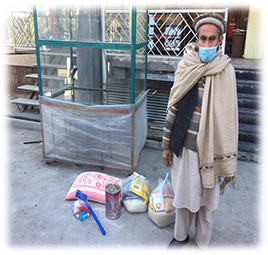
the people who received foods and sanitation items through the project
As of November 2020, the people in poverty had lost their daily work due to the covid-19. There are no alternative sources of income, and they received no significant assistance from the government or NGOs, other than limited assistance from their relatives and friends.
Then, we collected information about those people affected by the new corona from health department and identified 368 households, more fragile than the others. JEN urgently distributed foods and sanitation items (soaps, the detergents for toilet and clothes, etc.) to prevent new corona infections towards these 368 households (2,576 people).
Not only the project participants, but also the government have praised this effective distribution of the project. The monitoring after the distribution found out that the provided foods support their financial situation strongly and people said that they could prepare themselves to take care family incase if their family member got covid-19. We received such a hopeful answer from the project participants.
Emergency Assistance for the Mirpur District of the Azad Kashmir Territory to Combat COVID-19(April~May 2020)
We provided food and sanitary products (soap, bleach for cleaning the toilet, etc.) for 254 households in Mirpur most affected by the earthquake, and ultimately protected the community from the negative effects of COVID-19. Additionally, we distributed food to the same 254 households, as many of the people lost their day labor jobs due to lockdown measures against COVID-19, and were on the brink of a food crisis.
Although the items were transported to the households through a contractor, many members of the community volunteered to help guide the trader and our staffs to homes and carry materials inside. During the same time, the JEN staff held enlightenment discussing the importance of hygiene and sanitation (e.g.: washing hands with soap, etc.) with an emphasis on how it can be applied in this current pandemic.
In addition, it should be noted that these 254 households were selected from the 640 households (part of the target households in JPF’s Winter Earthquake Support Project, which ended in May of 2020) negatively affected by the major earthquake in September 2019. These 254 households showed significant loss of income due to the COVID-19 lockdown measures.


Winter Weather Equipment Distribution and Psycho-Social Support Project for the Earthquake Victims in the Mirpur District of the Azad Kashmir Territory(January 2020~April 2020)
In the Mirpur District of the Azad Kashmir Territory, we distributed cold weather tents and related non-food items (plastic mattresses, plastic sheets, and sanitation kits) to 640 households (approximately 4,480 individuals) most affected by the earthquake.
Through this, the households were able to adequately prepare for the upcoming winter.
At the same time, we implemented social psychological support efforts (counseling and social psychology education) with an emphasis on emotional care for individuals that had been affected by the earthquake and had concerns about restructuring their lifestyles.
Materials on IEC (Information, education, communication) regarding social psychological support were distributed to further enhance the public’s understanding of this topic. Individuals that suffered from significant emotional distress received individual counseling sessions, and if needed, were refereed to appropriate governmental clinics. We were able to establish a system in which when members of the Women’s Committee identified a case of significant emotional distress, the members will notify Focal Persons or FP (Community supporters that would connect members of the community experiencing significant emotional distress with appropriate specialists) who were selected for this project, and the FP then notify the local health department.


Local Infrastructure Enhancement Efforts Focused on the Renovation of Water and Sanitation Facilities in the Central Kurram District of Khyber Pakhtunkhwa (KP) Province(August 2018~2 October 2019)
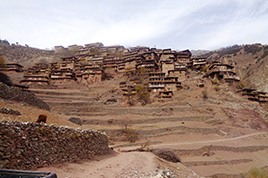
This project was centered around improvement of living infrastructure, with a focus on the renovation of water and sanitation facilities for the returnee population in the Kurram District.
As part of the water supply aid efforts, we worked to secure clean water supplies towards 2,500households in 38 villages through conservation of preexisting water sources, construction of 10 drinking water distribution schemes (supply lines, water storage tanks, surface water tanks, etc.), and implementation of water quality tests.
Furthermore, in order to ensure continuity of project efforts, 10 water management committees were formed, and through hosting trainings on facility management and maintenance, and distributing toolkits, the committees gained the ability to perform operation and maintenance duties independently.
As part of sanitation aid efforts, we conducted the following:
1.Distributed necessary sanitation and hygiene kits to 2,500 households in the 38 target villages and raised awareness of the importance of sanitation and hygiene
2.Constructed drainage systems in 22 of the 38 target villages
3.Constructed drainage systems for 6 elementary schools
4.Constructed sanitation and hygiene facilities (toilets and hand-washing stations) for 9 elementary schools
5.Educated students attending the target elementary schools (1,469 students) on the importance of hygiene habits
Within the community, we worked to maintain and improve sanitation and hygiene habits at both the individual and household level.
Restoring livelihoods and providing self-support (March 2016-February 2018)
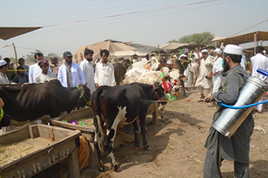
(Photo) Insecticide spraying of livestock to combat Crimean-Congo hemorrhagic fever in 37,500 households performed before the sacrificial festival.
(Photo taken September 2016)
The lives of returnees grew more chaotic due to the prolonged terror and mop-up operations. Many of them had never fully restored their homes that were destroyed in the conflict and were forced to struggle with economic insecurity as working day laborers, selling their property, livestock and jewelry, living with debts, and sharing food with their neighbors.
Simultaneously, Pakistan suffered from a variety of infectious diseases that affected mainly livestock, hindering them from rebuilding their lives, since households are engaged in both agriculture and livestock.
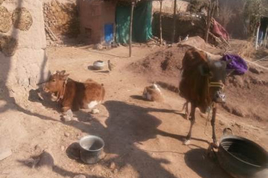
(Photo) Undernourished cattle due to lack of nutrition
(Photo taken January 2017)
JEN provided support materials to the most vulnerable among the returnees to help them regain their livelihoods. Said help was in the form of distributing cattle, vaccinations, deworming medicines, and nutritional supplements. In addition, JEN provided training in livestock management methods to raise people's awareness of possible issues. JEN completed this livestock support project in February 2018 in the Khyber District, Khyber Pakhtunkhwa Province (formerly Khyber District, Federally Administered Tribal Areas).
Raising livestock to regain livelihood (From January 2015 to Febrary 2016)
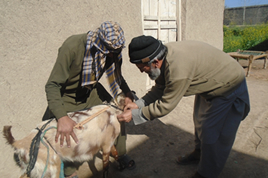
JEN provided food and anthelmintics for livestock and vaccination services to 500 households with internally displaced persons who had escaped from North Waziristan to the Bannu District. JEN also provided assistance to keep livestock healthy and to prevent livestock diseases. JEN distributed materials to 155 households (out of the 500 households) so that they could build livestock stalls for protection—to raise and take good care of their livestock. In addition, JEN recruited and trained livestock instructors. The instructors were selected from people who participated in assistance activities to improve awareness, such as how to prepare oneself in managing livestock. Furthermore, JEN established a Livestock Management Committee composed of senior members, livestock instructors, staff members of the Livestock Industry Bureau, and veterinarians in private practice. By the end of this assistance project, households—that JEN provided assistance—raised and took good care of their livestock. This contributed to securing food supplies and to regaining livelihood.
Emergency Assistance for the October 2015 Hindu Kush Earthquake (From November 2015 to January 2016)

A huge earthquake—a magnitude 7.5 earthquake with the epicenter located in Afghanistan—occurred in October 26, 2015. This earthquake also caused damages in Pakistan, a neighboring country. The earthquake caused severe damage in the Khyber Pakhtunkhwa Province, especially in the Shangla District. In addition to the deaths and injuries, 12,755 houses partially or totally collapsed. JEN conducted an emergency survey and then provided emergency assistance to 770 households in four districts. During winter in the Shangla District, a disaster-stricken region, the nighttime temperature can fall below -7 ℃. Therefore, providing assistance to the residents who were facing a severe winter weather was urgent. Accordingly, JEN distributed kitchen appliances—such as cooking pots, kettles, frying pans, spoons, and plates; as well as items necessary to survive through winter—such as quilted fabrics, cotton mattresses, pillows, children’s clothes, and women’s shawls.
Water and Sanitation Project (From April 2013 to the end of January 2014)

An environment where people can live a healthy life is necessary in order for the internally displaced persons to return home. JEN distributed roof-repair kits (bricks, doors, windows, and the like) to 145 households with returning displaced persons in the Kurram Tribal Agency, which is located in the Federally Administrated Tribal Areas (FATA). The returning displaced persons quickly took the distributed items home and began repairing their homes before the winter season started. In addition, JEN installed tanks and repaired pipelines in order to improve the water sanitation environment. Furthermore, JEN conducted workshops about sanitation to teach the importance of making handwashing a habit and to prevent diarrhea. As a result, personal hygiene habits primarily among women and children improved. A Water Management Committee has been established to maintain a mechanism so that the returning refugees have sustainable access to clean water.
Reintegration support project for internally displaced persons in Dera Ismail Khan Governorate (January 2012 - January 2013)
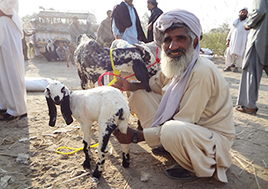
Project participants receiving goats
In Band Krai District, Paharpur District, Dera Ismail Khan Province, 2,727 internally displaced families (approximately 19,089 people) have begun to regain independent livelihoods through the distribution of goats, feed, other rearing tools, and goat management training (training and guidance of livestock instructors).
Livestock production instructors have been providing mating services and sharing goat management knowledge by distributing male goats to internally displaced people, contributing to the improvement of the goat rearing environment in the host community.
Distribution of goats to regain livelihood (July 2011 - December 2011)
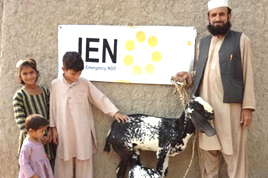
From the second half of 2011, JEN started distributing goats to the internally displaced persons living in the Dera Ismail Khan District of Khyber Pakhtunkhwa Province as part of JEN’s assistance so that the internally displaced persons could regain livelihood. In order to conduct the assistance activities, JEN selected livestock instructors from the internally displaced persons. JEN also collaborated with the Prefectural Livestock Bureau to conduct training for the instructors. JEN asked these instructors to play a role in disseminating knowledge to the other households with displaced persons about how to breed goats and about goat management.
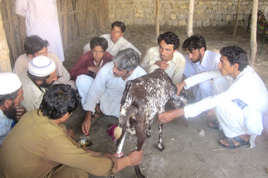
JEN conducted a survey to examine the development after the goat distribution. The survey showed that people used the goat milk to help improve their living conditions—they consumed the goat milk at home, sold goat milk at the market, and the like. The survey also showed that in approximately 25% of the 500 households—in which the goats were first distributed—the does had given birth for the second time. Some of the internally displaced persons sold the young goats immediately as they had urgent expenditures such as medical expenses for family members who were ill. However, most of the internally displaced persons have not sold the young goats yet and are still raising them. They are hoping that the value of the goats will increase when the does grow up.
Support for flood victims in Pakistan (August 2010 - July 2011)
In August 2010, after assessing the damage caused by flooding from record-breaking heavy rains, JEN identified 600 households (5,151 people) to require immediate help. Said households affected by flooding in Kohat District, Khyber Pakhtunkhwa (KP), distributed urgently needed NFIs (tents, plastic sheets, beds, plastic mats, water coolers, gas cylinders, hygiene kits with buckets, kitchen sets, and mattresses). The distribution of NFIs provided immediate support. In addition, 2,840 families (20,788 people) whose houses were destroyed by the floods in Charsadda, Charsadda Province, were able to repair their houses with the housing materials and tool sets they received, eventually able to move into the restored houses. 2,375 farming households (approximately 16,625 people) in Charsadda, who had been unable to farm, were able to rehabilitate their farmland based on the knowledge they received from trainings and experts, allowing them to resume farming using the agricultural kits (seeds, fertilizers, and farming tools) they received.

Recipients after the distribution

Farmland restoration work
Distribution of emergency relief supplies (From June 2009 to September 2009)
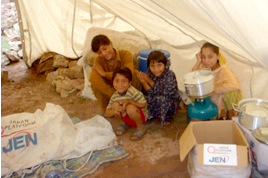
The internally displaced persons who had escaped from the battle between the government and the Islamic armed groups evacuated to Pakistan’s North-West Frontier Province. Approximately 700 and 500 households evacuated to Narai Area in Mardan District and to the Panjpir Area in the Swabi District, respectively. JEN provided assistance to these regions by giving out tents for shelter, kitchen appliances, and the like to 1,200 households (approximately 9,000 people) with displaced persons who had escaped from the battles without anything but the clothes they were wearing. JEN provided these items so that the displaced persons could live in the evacuation centers. JEN provided instructions on how to assemble the tents and how to maintain the tents during tent distribution in order to promote the victims’ sense of ownership. JEN also distributed the tents to the community so that the tents could be used continuously and for a long time as warehouses.
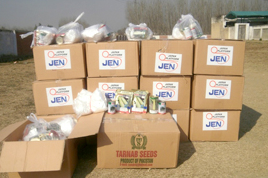
Furthermore, the survey that collected the information about the local needs showed that this area required measures against summer heat. There were many mosquitoes in the evacuation areas. JEN distributed mosquito nets and foldable beds so that the displaced persons could sleep safely. At the same time, deteriorating sanitary condition was a serious problem among displaced persons who lived in small and heavily populated areas. JEN also distributed hygiene kits in these areas.
Providing emergency assistance for the “2008 Ziarat earthquake”—Earthquake in Southwestern Pakistan (From October 2008 to April 2009)
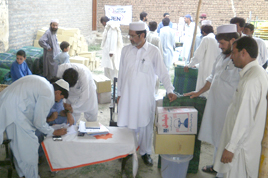
A magnitude of 6.4 earthquake occurred in the Balochistan Province—located in the western region of Pakistan—on October 29, 2008. More than 160 people were killed, more than 370 people were injured, and more than 7,000 people were displaced. The disaster-stricken area is a mountainous area with an elevation of approximately 2,400 meters. The nighttime temperatures fall below zero degrees Celsius. Many residents were forced to live outdoors even under such harsh natural environment. These residents lived in harsh conditions as their everyday goods, such as cooking appliances, were buried in the debris; they had to rely on meals distributed by the local NGOs for daily meals.
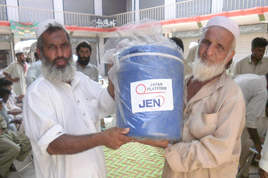
JEN provided supplies that were necessary and urgently needed to the victims of the earthquake and supported the victims’ daily life for the time being. At the same time, JEN helped in preventing secondary damages, which include damage to victims’ health (from the severe cold temperatures and the deterioration of sanitary conditions), psychological damage (from uncertainty about their life), and the delay of reconstruction (due to the delay in debris removal). JEN distributed emergency supplies—such as tents for surviving through the winter, daily necessities and daily tools, and tools for removing debris and for rebuilding houses—to the Ziarat District and the Pishin District, the districts worst affected by the earthquake.
Emergency and reconstruction assistance for the 2005 Kashmir Earthquake (from October 2005 to October 2008)
“Especially in education—to people living in hard-to-reach areas”
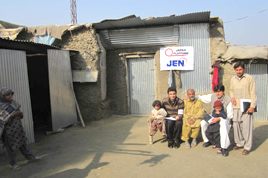
Immediately after the earthquake, JEN provided assistance to the victims living in the mountainous areas—where there was little support—in the Bagh District where assistance tend to be left behind. In particular, JEN provided assistance when media coverage and support for the 2005 Kashmir earthquake had decreased. JEN provided continuous assistance—from emergency assistance to reconstruction assistance—that were long-term and tailored to meet specific local needs in cooperation with the local people.
School reconstruction project (From June 2008)
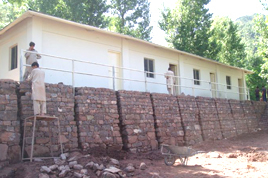
In UC (Union Council) Kalamura, the temperature drops below zero degrees Celsius during the winter. JEN built six schools in UC Kalamura of Haveli, Bagh District, so that the children who were studying outdoors could study in a safe and a comfortable environment. These schools are earthquake resistant and made of lightweight reinforcing steel.
This district is located halfway up the mountainside and away from the major roads. Therefore, JEN had to make a slow and steady effort. This process included disassembling the materials to small pieces, gradually carrying these materials to the construction sites, and assembling these materials. The School Management Committee—composed of schoolteachers, parents or guardians, and local residents—and JEN worked together for the school construction; they decided that the committee would manage and operate the school buildings.
Hygiene education project (From June 2008)
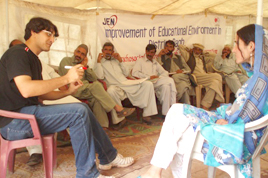
JEN conducted workshops about hygiene education to teachers and members of the School Management Committee in 20 public schools located in UC Bhedi of Bagh District. The purpose of the workshops was for the teachers to continue hygiene education by themselves. The teachers considered using teaching methods so that the children could acquire correct hygiene knowledge. The teachers conducted workshops about hygiene education—while receiving advice and support from JEN’s staff members—through group discussions and skits to children in each school.
Education support project (From July 2007 to July 2008)
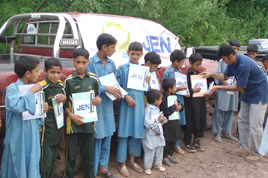
In Haveli of Bagh District—where JEN provided assistance—216 school buildings (90% of all schools) had collapsed and 151 school buildings needed to be rebuilt due to the earthquake. Rebuilding of schools was significantly delayed since rebuilding of residents’ home was the priority in Haveli. Only nine schools (out of all schools)—including two schools built by JEN—were rebuilt in Haveli. As a result, children were forced to take classes in tents, temporary classrooms, or outdoors. JEN constructed one school in Basti Chanjar.
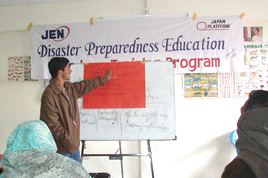
In addition, education on disaster prevention had not been disseminated in the local area. Therefore, JEN conducted an education program about disaster prevention to teachers in six schools, including five schools around this area. Through this education program, the residents were able to acquire basic knowledge about disaster prevention; JEN aimed to reduce the fear of and the anxiety about the earthquake.
Water and sanitary conditions improvement project (From September 2006 to December 2007)
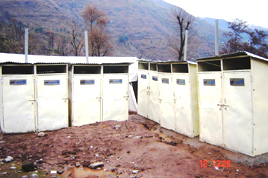
Many local school buildings did not have bathrooms or places to wash hands. Therefore, JEN provided assistance by creating places to wash hands in schools located in disaster-stricken areas so that the children could drink safe water at their schools. In addition, by installing toilets at school buildings, female students could take classes without worrying about lack of toilets. Furthermore, JEN not only installed toilets and created places to wash hands, but also conducted hygiene education to students so that they could acquire correct knowledge about hygiene practices and could prevent illnesses by using toilets and places to wash their hands correctly.
Assistance project on improvement of educational environment—Phase 2
(From December 2006 to May 2007)
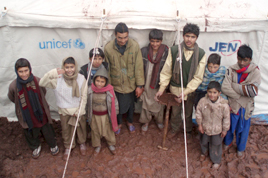
Earthquake survivors had to face a second winter season since the earthquake. Nevertheless, the students were still learning in school tents since the rebuilding of school buildings was significantly delayed in the local areas. However, since the tents were originally made to last for a year, they had deteriorated. Therefore, JEN repaired school tents and distributed desks and chairs so that the children could continue learning even during the second winter season. JEN provided assistance so that the children could continue learning indoors and in a safe environment. Furthermore, JEN conducted training on disaster prevention education for the teachers and assisted children and teachers to acquire correct knowledge about disaster prevention. Through disaster prevention education, the children were able to acquire correct knowledge about earthquakes, thereby reducing their fear of earthquakes.
Assistance project on improvement of educational environment—Phase 1
(From May 2006 to December 2006)
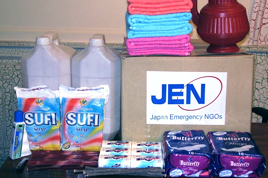
In the steep and mountainous areas that were especially severely schools (one of which was a girls’ school) so that the buildings could become earthquake resistant. These two schools were the first ones to be rebuilt in the Bagh District, where reconstruction was significantly delayed. In addition, JEN conducted education about earthquakes to residents who did not have a basic knowledge about earthquakes and this helped improve awareness about disaster prevention. Furthermore, JEN distributed hygiene kits; and along with this distribution, JEN conducted workshops for hygiene education to provide assistance to improve the living conditions of children and residents who were living as evacuees. (Contents of hygiene kits) Towels, soap, shampoo, sanitary items.
Emergency educational assistance project (From January 2006 to May 2006)
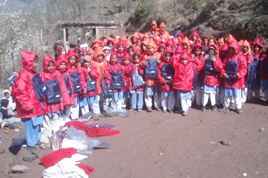
With the support of Japan Platform, UNICEF, and the donors, JEN was able to set up 250 classroom tents and install 39 temporary toilets for school buildings that collapsed in Haveli, Bagh District. Furthermore, JEN distributed stationery necessary for teaching (blackboards, chairs, stationery sets) and warm winter clothes necessary to survive the winter. JEN also provided assistance so that the children who were studying outdoors in the cold could take classes in the tents. As a result, 21,221 children—who were affected by the earthquake—could continue learning in the indoor environment during the severe winter season.
Distribution of emergency assistance supplies (From October 2005 to February 2006)
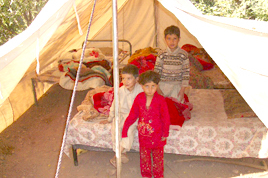
In the Bagh District, 90% of the buildings were seriously damaged or had partially collapsed; and people remained outdoors due to fear of aftershocks. JEN conducted interviews and surveys from October to the end of December to ask about what the people urgently needed while living in the disaster-stricken areas during the winter. Thereafter, JEN distributed daily necessities and warm winter clothes. Daily necessities included residential tents—which most people wanted to have—blankets, kitchen appliances, hygiene products, and the like. JEN also distributed 2,000 residential tents. JEN did not distribute the same set of daily necessities items to everyone, but adjusted the items so that only the necessary items were distributed to the people who needed them. In total, JEN was able to provide assistance to 5,716 households—approximately three times higher than estimated.
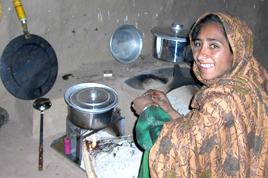
JEN decided on the details of assistance by listening to the victims’ voices; therefore, the distributed goods were put to good use. For example, JEN chose a small water bucket—that is utilized for toilets—and a set of kitchen appliances made for six to eight people for large families. Family members, especially women, were very pleased with these distributed goods and are active at home every day.
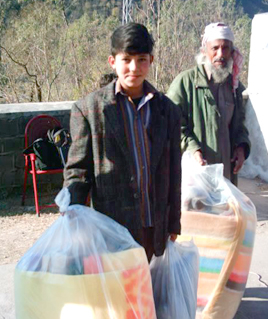
The 12,518 warm winter clothes and the like distributed by JEN were donated by Fast Retailing Co., Ltd. (UNIQLO, a primary subsidiary of Fast Retailing Co., Ltd.). The 5,000 blankets distributed by JEN were provided by the Movement Promotion Committee of Japan Blankets For Africa Campaign. In addition, Pakistan International Airlines, MOL Logistics (Japan) Co., Ltd., and Nippon Yusen Kabushiki Kaisha (NYK Line) supported us in transporting the goods.
